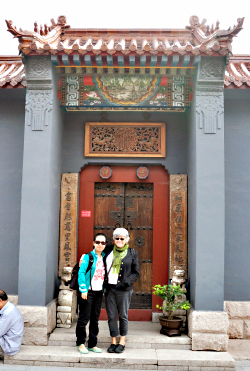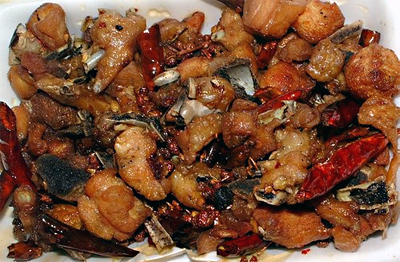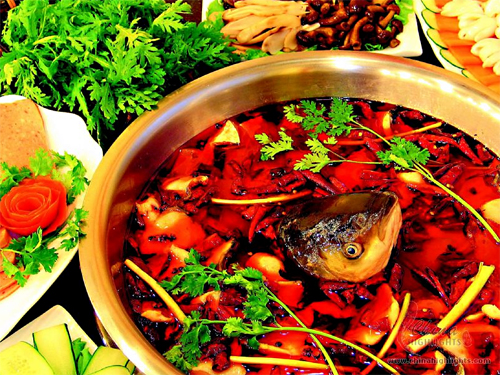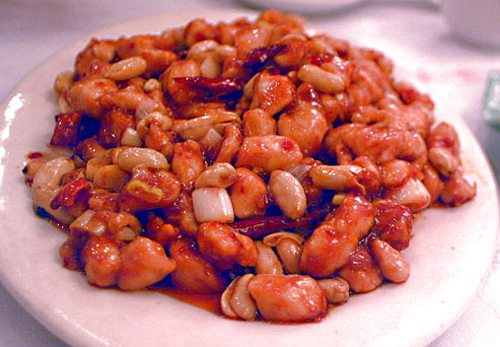
Recipes
Kung Pao Ji Dian: Chicken with Peppers and Peanuts
Eggplant with Peanut Sauce
One of the most common questions people ask when we come back from China is: is real Chinese food in China anything like the Chinese food we get in Canadian Chinese restaurants?
The fast answer is no. North China is a wheat, not a rice culture. Tea costs as much as coffee, which is much as a plate of beef and eggplant.
We’ve just returned from an emergency trip to Tianjin. My job was to replace an instructor who bowed out at the last moment before the new spring term started on March 19. For two weeks we breakfasted in our hotel and dined in restaurants. While we didn’t love every single meal, the overall experience renewed our admiration and respect for the Chinese way of eating.
Stir Fried Bok Choy for Brekkers
Who would have thought stir-fried cabbage could be a breakfast hit? Bok choy, stir fried with a little pepper, tiny bits of chicken, some celery and a bit of shredded omelette plus some dried red pepper, becomes quite addictive. Add to this stir-fried noodle and rice with very finely chopped carrot and onion, plus a hard-boiled egg, plus toast, cereal or congee (rice porridge) and fruit, add pickles and sliced tomatoes and cucumber, and you have a breakfast fit for an emperor. All this for 8 yuan (RMB, or Renminbi) a day, the equivalent of about $1.20.
Yogurt aids digestion
In the north, the Chinese consume masses of yogurt: shelves of it line every grocery store: yogurt drinks, yogurt smoothies, plain yogurt, fruity yogurt, and now even yogurt with muesli in it. Kids bring it to class for breakfast on the run, restaurants serve it, convenience stores stock it. Like here, only the shelves that would be filled with pop are full of yogurt. The sugar content is probably similar, but even so it must be healthier than soft drinks. And when you are unwell, the enzymes in yogurt replace those lost through ill health. One idea is to take yogurt tablets daily for two weeks before you leave on your travels — the acidophilus conditions the lining of your digestive track making stomach upset less likely.

A nice cup of hot water
Our Chinese friends habitually drink neither tea nor coffee, and when they came to our apartment, asked for water, hot if possible and room temperature if not.
In North China, serious environmental problems encroach on water supplies; drought and enormous industrial uses mean that most people are aware that water is precious. In public places water is often unavailable, and the sale of water in plastic bottles is ubiquitous. You buy bottled water at 30 yuan (about $4-5) per 5-gallon tank — the water-delivery bicycle carts piled six feet high these are a common street scene.
The Chinese are serious about eating for health, and hot water is one mark of this. I found it both invigorating and, once you get used to the absence of tea or coffee, very sweet-tasting. This is a habit I will keep — even now, I drink a cup of hot water while I’m getting dinner. It’s soothing somehow, and contributes to the 8 cups of H2O we should consume daily. Sipping is easier than gulps. Plus a restaurant will bring it to you for free.
Small plates make less seem more
A Chinese lunch or dinner is served on a small plate and a small bowl, plus a little cup, and a set of chopsticks. In restaurants, these sometimes are set out in plastic-wrapped packages, to ensure cleanliness. The food arrives on platters or bowls (for soup) in the middle of the table — on a lazy Susan, if the table is large. Diners help themselves to what they want, putting just a small quantity on the plate or in the little bowl. When that’s done, another helping is within easy reach.
Rice is considered in North China a filler food — it arrives last at the table unless you ask for it to be served with the other dishes, which is slightly insulting to the chef. It will not come automatically, as it does with Cantonese meals, and you will pay for it separately — about 2 yuan. You are meant to fill up on the vegetables, meat, soups and fish that arrive almost as soon as you sit down, but not all at the same time.
The drawback, for the home cook, is the number of large serving dishes used. On the upside, no large dinner plates accumulate. But the real benefit is that you tend to eat exactly what you want and need. ALL Chinese restaurants provide take-away cartons for the left-overs. (When we were first in China, we ate in the evening exclusively from leftover cartons from lunch.)
Waste not, want not.
Restaurant menus are large and full of photos that gleam appealingly but often turn out to depict things such as tripe, chicken feet, pork belly, and pigs’ ears, all in yummy looking sauce. Unless you can read Chinese characters, the descriptions are a mystery. The lesson here is that in China, every part of plant or edible animal (no, we have not eaten dog, cat or donkey — although there are shops specializing in the latter) is considered edible.
During the Cultural Revolution, 30 million people died of starvation in China. Since then, the Chinese government has made food supply and distribution a priority. The abundance of food is astonishing: on the street, in supermarkets, in small shops, in hotels and restaurants, food is plentiful, inexpensive by Western standards, usually fresh, and delicious. But the memory of the famine years dies hard, and nothing is refused, all is used. Fish head is a menu item, as are pork trotters and pigs’ ears and snout. While Western cultural food inhibitions mean raised eyebrows and wrinkled noses, it may be healthier to eat these items as they come rather than stuff them, minced, into sausages, especially in an environment where refrigeration may be unreliable.
Fish eyeball, frozen, thinly sliced and cooked in a hot pot dish, tastes and feels more or less like the skin on unflavoured gelatine. The trick is not to think about it.

Hot pot cooking
Not knowing how or what to order from a menu of good photography but indecipherable Chinese characters, we found the hot pot restaurants a great boon.
A chafing dish sits in the middle of the table. The waiters light it, then bring one of several choices of broth — chicken and herbs, or beef and garlic, or fish, along with flavourings such as dates, garlic, onions and ramps (wild garlic.) You order plates of thinly shaved meat, fish or chicken, which come beautifully arranged on the plate usually in a large flower pattern with each slice as a petal. (These are sliced while frozen.) Or you can order a whole fish.
We chose lovely bowls of fresh greens — the Chinese grow a huge variety of lettuce-like green leaves that even they don’t name — they’re just “greens” — and the jiaozi, little dumplings, which in one restaurant they came in 4 colours — white, orange, green and lilac—lined up in lovely squares on a white platter. These were tiny, but an ample meal for two.
You eat hot pot fare with sauces, usually set out as a buffet, and we helped ourselves to whole and chopped peanuts, sesame paste, bowls of finely diced onion and garlic, spinach, tomatoes, watermelon, kumquats, rice and potatoes. The food is fresh, you cook it right at the table to your liking, and the whole experience is one of light food prepared without fat and seasoned to personal taste.
If you go to China, here’s a web site that you might find useful. You can print the photos with the Chinese characters, and also listen to the audiotape to learn how to pronounce these dishes. I’ve used their photos, as when we were in China I never remembered to bring my camera out for dinner. http://www.beijingtraveltips.com/chinese_food_guide/chinese_food_guide.htm

Kung Pao Ji Dian: Chicken with Peppers and Peanuts
Both these recipes are inspired by the beautifully illustrated cookbook called Martin Yan’s China (2008). I’ve changed the quantities because our variety of some of the ingredients — Hoisin sauce for instance — seem to be very strong. We ate them at home with quinoa rather than rice, but this is untraditional. Didn’t see any quinoa in China.
Kung Pao sauce is a Szechuan dish but very popular in North China. Once you have the sauce, you can “kung pao” almost any stir fry. This dish uses traditionally chicken off the bone, peanuts and a huge handful of dried red peppers. I used a jalapeño instead of all the dried red chilis. If you like food really spicy, leave the whole pepper in the sauce rather than straining it out as I did, or use the dried red chilis.
In Yan Jiao, where we lived in 2008-09 and again last summer, this dish is invariably flavoured with Szechuan peppercorns. Like celery, they have a slightly numbing effect on the palate and a medicinal taste. I dislike them, and have replaced them with celery, which adds crunch to the dish.
First, roast a clove of garlic, cut in two and rubbed with oil, then wrapped in tin foil, in a 350° F oven for 30 minutes.
Then make the sauce.
Kung Pao Sauce
2 tbsp balsamic vinegar
¼ cup chicken or vegetable broth (from cubes)
3 tbsp Chinese rice wine
2 tbsp sugar
1 tbsp sesame oil
2 tsp soy sauce
2 tsp chili garlic sauce (Asian foods section of the supermarket)
Mix these in a small bowl.
Heat 2 tsp oil in a wok; add 1 jalapeño pepper, thinly sliced. Fry the pepper until it just starts to turn brown on the edges.
Pour in the sauce and stir for 2 minutes over high heat. Add
2 tbsp water mixed with 1 tsp crn starch
and continue to stir and mix until the sauce thickens slightly. Remove from heat and strain into in a small bowl.
Stir fry in 2 tsp vegetable oil the following, all diced:
2 skinless boneless chicken breasts, cut up into ½ inch pieces
4 large stalks celery
8-10 green onions
1 whole clove roasted garlic (see above) (The garlic buds will easily squeeze out of the skin once roasted.)
1 jalapeño pepper, deseeded and white membrane removed (that’s where the heat, rather than the flavour, reside.)
Once the chicken is beginning to look cooked, add the kung pao sauce and continue to stir fry over high heat for another 5-8 minutes, or until you are sure the chicken is cooked and the celery is tender-crisp.
Now add ¾ cup of roasted unsalted peanuts. (I roast mine in the oven at 250° for 20 minutes to make sure they are crisp.)
Eggplant with Peanut Sauce
One of our favorite vegetarian meals in China is a dish of eggplant and some rice. It’s very rich — a friend eventually revealed the secret of the silky texture of Beijing eggplant — it’s saturated in oil. This recipe doesn’t use oil at all except a little in the sauce, so despite the very rich flavour, it has fewer calories than the restaurant variety.
1 regular eggplant or 3 Japanese eggplants
½ cup peanut sauce (below)
Boil a big pot of water and put the eggplant into this for 8-10 minutes or until you can poke a knife into the vegetable without meeting resistance. Remove the eggplant from the pot and cool slightly. When it’s cool enough to handle, slice it lengthwise and then crosswise so that you have pieces about the size of your thumb. Put these into an ovenproof dish — a relatively small one, so you have several layers of eggplant slices.
Peanut Sauce
2 tsp vegetable oil
3 cloves garlic, minced
1 cup chicken or vegetable broth
1/8 cup Hoisin sauce
3 tbsp natural (unsalted “peanuts only”) peanut butter
1 tbsp fish sauce
1 tsp chili garlic sauce
1 tsp brown sugar
1/3 cup unsalted roasted peanuts, chopped
Sauté the garlic in the oil over medium heat for 3-4 minutes. Add the other ingredients and stir well. Bring to a boil over medium heat and stir until slightly thickened. Add the chopped peanuts.
Pour ½ cup of this peanut sauce over the eggplant slices and keep warm in a 250° F oven while you make the rest of the meal. It will continue to cook and acquire a lovely silken texture that complements the intense flavours of the sauce.
The sauce will keep, in a covered jar in the fridge, for a week. This peanut sauce can also be used for chicken on skewers, e.,g. chicken saté.



